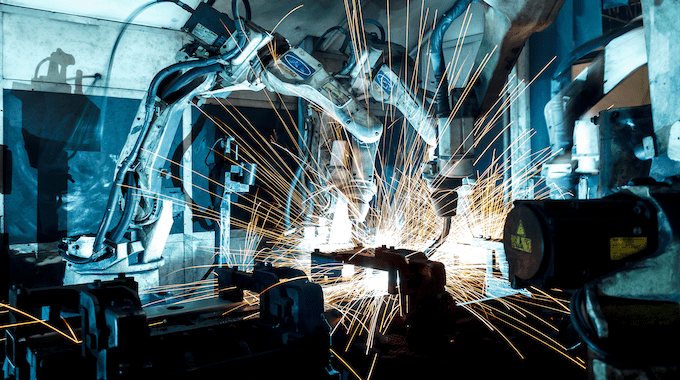- Solutions
ENTERPRISE SOLUTIONS
Infuse new product development with real-time intelligenceEnable the continuous optimization of direct materials sourcingOptimize quote responses to increase margins.DIGITAL CUSTOMER ENGAGEMENT
Drive your procurement strategy with predictive commodity forecasts.Gain visibility into design and sourcing activity on a global scale.Reach a worldwide network of electronics industry professionals.SOLUTIONS FOR
Smarter decisions start with a better BOMRethink your approach to strategic sourcingExecute powerful strategies faster than ever - Industries

Compare your last six months of component costs to market and contracted pricing.

- Platform
- Why Supplyframe
- Resources
Industry 4.0 has brought with it a rise in automation across manufacturing. The optimization of our factories joins together with a massive exchange of data. Whether it’s smarter robotics, the internet of things, or cutting-edge artificial intelligence, industrial automation enjoys more options than ever.
Amidst this fourth industrial revolution, it’s important that we keep our focus intact. There are plenty of new innovations that will seek your investment, but only a select few of them are actually ready for adoption. Differentiating between hype and truly disruptive technology is a skill the decision-makers in your organization need to possess. Let’s take a look at how you can learn this skill and test your knowledge in the process.
Leveraging Hype Cycles
Gartner is a leading research and advisory company that was founded in 1979. Their goal is to give executives the knowledge and insight to make smarter decisions. One of the firm’s premiere innovations is something called the Gartner Hype Cycle.
While you may have heard about this model, a deeper look allows us to quickly identify the skills we need to judge technology and its place within the cycle. These are the main phases:
- Innovation Trigger – This is the big bang for a new concept. Stories flood the media and concepts abound, but there are rarely any useful products at this point
- Peak of Inflated Expectations – As a result of the hype from early media reporting, the concept enjoys plenty of time in the limelight, but often the shortcomings follow shortly thereafter
- Trough of Disillusionment – In this stage, it’s sink or swim. When inflated expectations are not met, the creators must adapt or fail. This is where truly disruptive tech innovates further to impress their early adopters
- Slope of Enlightenment – The true use cases for the tech become solidified as the widespread usage begins to happen across the industry. New versions of the concept release with additional improvements
- Plateau of Productivity – Finally, the tech achieves mainstream adoption. Here the technology finds itself comfortably resting within its relevant market
Leveraging this model allows you to better understand where a technology or innovation stands, thus informing your investment decisions and helping your mitigate risk by avoiding tech that’s still in its early stages.
Disruptive Tech vs Pure Hype: Can You Tell The Difference?
When the conversation turns to disruptive tech, it won’t be long before you start hearing buzzwords. Artificial intelligence, blockchain, the Internet of Things, and the list goes on. With so many new ideas, technology, and startups hitting the market, it’s incredibly important that you have a strong understanding of where ideas stand.
A skill like this will allow you to see through marketing campaigns and hype generated from the media and press. Ultimately, it lets you take a step back and see if this type of innovation is at a place where it will benefit your organization.
Now, in some cases, early adoption can be a good thing, but you’ll need to weigh the costs and benefits accordingly before you make a decision. In either case, knowing a concept’s place on the curve is a powerful way to put things in perspective.
In the spirit of this, try looking at these six examples and see if you can guess where they fall on a typical hype curve:
Machine Learning
Machine learning falls under the umbrella of artificial intelligence, but the concept is focused more on algorithms and data than something like a neural network that AI is more commonly associated with. By using sample data, these algorithms are able to make predictions or decisions without expressly being programmed to do so.
In practice, machine learning is used across manufacturing and in various applications of big data. Providing these algorithms with large amounts of data empower them to make predictions about maintenance in your factory, or how to better optimize your processes.
Machine learning has also found its way into plenty of other applications, ranging from email filtering to fraud detection, and even virtual assistants. Knowing this, here’s where it stands:
Status: Slope of Enlightenment
Blockchain
Blockchain gained mainstream popularity for its use in cryptocurrency, but the technology itself has applications far beyond that. In summary, Blockchain is a distributed ledger that chronologically stores records that can be accessed publicly, but does allow anyone to change the record.
This rigid method of record management and traceable records makes it an ideal way to remove a middle party like a bank and allow transactions to flow freely in a secure space.
Beyond finance, Blockchain has begun to move into healthcare, manufacturing, and the supply chain. According to Gartner, Blockchain is expected to create $3.1 trillion in business value by 2030, but given that it’s still somewhat immature, where do you think it stands on the curve?
Status: Trough of Disillusionment
Digital Twins
The concept of digital twins has been around for some time, but as technology races to meet with concepts, the idea is evolving. Modern digital twins are computational representations of real world objects or mechanisms.
An example would be a 3D model of an aircraft engine. With this type of realistic model, engineers and manufacturers can test scenarios and predict how the engine would work in the same real world scenario.
A modern digital twin includes a data model, analytics, algorithms, and prior knowledge. The focus in today’s world of electronics and manufacturing is combining it with IoT to widen its scope.
The goal is to achieve real-time monitoring and improved efficiency through a stronger model that is able to predict and prevent errors or breakdowns. The core concept is sound, but the applications are still evolving. This is where digital twins stand:
Status: Peak of Inflated Expectations
Virtual and Augmented Reality
Virtual and augmented reality, combined with a third concept: mixed reality, all fall under the umbrella of immersive tech. These types of tools allow us to see the world in a different light or visualize data in ways that we never could on a screen.
Gartner also predicts that 70% of enterprises will be experimenting with this tech by 2022. Specifically, the tech seems destined for conversational uses like chat bots, which will have the capacity to detect a user’s emotions based on their facial cues.
Applications for this technology in manufacturing come in a variety of forms. Ford, for example, has embraced VR to allow their specialists to design cars entirely within a virtual environment.
In a similar fashion, AR offers applications for inventory management. DHL applied this concept to their warehouses by provided workers with Google Glass and other displays that helped worker navigate to the correct area of the warehouse.
When they arrive, the box they need appears in their vision, making it easy to spot among similar packaging. Since these innovations, however, immersive tech has seen less time in the spotlight, resulting in its current status:
Status: Trough of Disillusionment
Quantum Computing

Quantum computing is an emerging tech that has huge applications. These include pattern recognition, data analysis, and plenty more. The concept utilizes quantum bits, or “qubits,” to define information. The easiest way to grasp this technology is to think about it like this:
A traditional computer would analyze a list of data one line at a time, moving forward in a linear fashion. A quantum computer would analyze everything at once, moving through the data in a parallel fashion and completing the task exponentially faster.
Quantum computing is still very much in the early stages, but this represents a perfect opportunity for businesses to research its applications and understand where it could be useful across the supply chain. Given its fledgling state, here is where Quantum computing stands:
Status: Innovation Trigger
Industrial IoT
Connecting devices together, sharing data, and improving visibility are all promises you’ll hear from industrial IoT. The reality is that the technology is still catching up. There’s no doubt that this tech could revolutionize industrial automation and enhance day-to-day operations in significant ways, but we’re not quite there yet.
That being said, if we stop to imagine a connected factory (or factories), things get exciting pretty fast. Imagine being able to view the status of all your automated devices at once. Combined with other tech, you could also predict when something may go wrong. This provides an opportunity to send in an engineer that performs preventative maintenance.
This is clearly something you could and should embrace, but how do you know where to begin? Start with research and obtain an understanding of the industry as a whole. Next, create a plan to implement this type of technology, but start small. This is something where early adoption could really pay off, but only if you move at a sustainable pace.
Given this, here is where industrial IoT stands on the curve:
Status: Peak of Inflated Expectations
Staying Ahead of The Curve
A deep understanding of hype cycles empowers you to approach everything with a level head. In the world of manufacturing and tech, that is an invaluable skill to have. Of course, attracting talent also requires chasing the latest and greatest tech, so there’s a balance you need to strike.
Establish your needs, do your research, plan ahead, and keep expectations in check. A combination of these things will ensure you always come out ahead of the hype curve.



